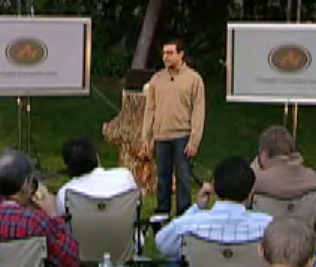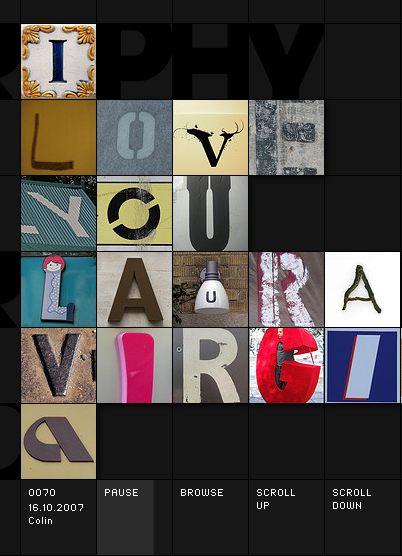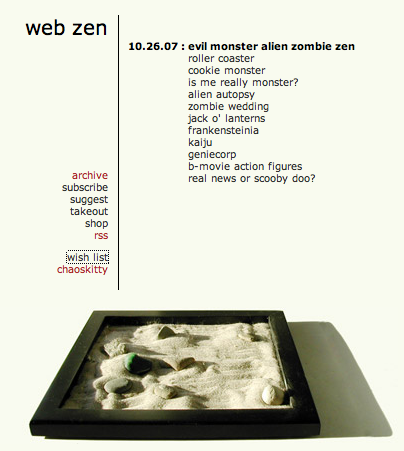Edware Vanhoutte, who has done some of the best work on the history of humanities computing (though much is not yet published), has started a blog. In his first entry, The Mind Tool: Edward Vanhoutte’s Blog, he summarizes early text books that were used to teach humanities computing. It would be interesting to look at how these 70s and 80s books conceive of the computer and how they differ from the 50s and 60s work like that of Booth.
TiltViewer
 TiltViewer is a fascinating way to look at Flickr pictures. It is by the same guy who created Simpleviewer – a Flash image viewer. I read about this on Shawn’s Randomosity blog.
TiltViewer is a fascinating way to look at Flickr pictures. It is by the same guy who created Simpleviewer – a Flash image viewer. I read about this on Shawn’s Randomosity blog.
OpenSocial – Google Code
 Two days ago, on the day of All Hallows (All Saints), Google announced OpenSocial a collection of APIs for embedded social applications. Actually much of the online documentation like the first OpenSocial API Blog entry didn’t go up until early in the morning on November 2nd after the Campfire talk. On November 1st they had their rather hokey Campfire One in one of the open spaces in the Googleplex. A sort of Halloween for older boys.
Two days ago, on the day of All Hallows (All Saints), Google announced OpenSocial a collection of APIs for embedded social applications. Actually much of the online documentation like the first OpenSocial API Blog entry didn’t go up until early in the morning on November 2nd after the Campfire talk. On November 1st they had their rather hokey Campfire One in one of the open spaces in the Googleplex. A sort of Halloween for older boys.

Screen from YouTube video. Note the campfire monitors.
OpenSocial, is however important to tool development in the humanities. It provides an open model for the type of energetic development we saw in the summer after the Facebook Platform was launched. If it proves rich enough, it will provide a way digital libraries and online e-text sites can open their interface to research tools developed in the community. It could allow us tool developers to create tools that can easily be added by researchers to their sites – tools that are social and can draw on remote sources of data to mashup with the local text. This could enable an open mashup of information that is at the heart of research. It also gives libraries a way to let in tools like the TAPoR Tool bar. For that matter we might see creative tools coming from out students as they fiddle with the technology in ways we can’t imagine.
The key difference between OpenSocial and the Facebook Platform is that the latter is limited to social applications for Facebook, as brilliant as it is. OpenSocial can be used by any host container or social app builder. Some of the other host sites that have committed to using is are Ning and Slide. Speaking of Ning, Marc Andreessen has the best explanations of the significance of both the Facebook Platform phenomenon and OpenSocial potential in his blog, blog.pmarca.com (gander the other stuff on Ning and OpenSocial too).
YouTube – The Long Johns – The Last Laugh – George Parr – Subprime
The best (and funniest) explanation of the subprime meltdown I have come across. YouTube – The Long Johns – The Last Laugh – George Parr – Subprime, courtesy of Marc Andreessen’s blog.pmarca.com where I first saw it.
Republican Debate: Analyzing the Details – The New York Times
 The New York Times has created another neat text visualization, this time for the Republican Debate. The visualization has two panels. One shows the video, a transcript, and sections. You can jump the video using the transcript or section outline. The other is a “Transcript Analyzer” where you can see a rich prospect of the debate divided by speeches and you can search for words. What is missing is some sort of overview of what the high frequency words are and how they collocate.
The New York Times has created another neat text visualization, this time for the Republican Debate. The visualization has two panels. One shows the video, a transcript, and sections. You can jump the video using the transcript or section outline. The other is a “Transcript Analyzer” where you can see a rich prospect of the debate divided by speeches and you can search for words. What is missing is some sort of overview of what the high frequency words are and how they collocate.
So, I have created a public text for analysis in TAPoR and here are some results. Here is a list of words that are high frequency generated using the List Words tool. Some interesting words:
People (76), Think (66), Know (48), Giuliani (42), Clinton (33), Reagan (13), Democrats (16), Republicans (11)
Health (45), Government (35), Security (35), Country (25), Policy (16), Military (15), School (15),
Marriage (23), Insurance (23), Conservative (23), Private (22), Let (21), Gay (12)
Iraq (13), Iran (12), Turkey (7), Canada (2), Darn (2), Europe (5),
Immigrants (5), Citizens (2)
Man (7), Mean (7), Woman (4), Congressman (25)
Answer (10), Problem (10), Solution (5), War (12)
Continue reading Republican Debate: Analyzing the Details – The New York Times
Bible-copying Robot
 boinboing has a short entry about a German robot that is exhibited writing out the bible. The robot is a RobotLab project (site in German.) The image comes from Marc Wathieu’s Flikr set for the RobotLab where the description of the project reads:
boinboing has a short entry about a German robot that is exhibited writing out the bible. The robot is a RobotLab project (site in German.) The image comes from Marc Wathieu’s Flikr set for the RobotLab where the description of the project reads:
The Kuka robot is silently writing a version of the martin luther bible, which was originally printed in a early font called “Schwabacher”, retranslated here by RobotLab into calligraphy. “Wolfgang von Kempelen, Mensch-[in der]-Maschine” exhibition, ZKM, Karlsruhe (D).
From the lab site it seems they have also programmed it to draw portraits.
Thanks to Lynn for this.
Typography Kicks Ass: Flickr Bold Italic
 Typography Kicks Ass: Flickr Bold Italic is a Flash toy that displays messages left by people using letters from Flickr. It is a “letters in the wild” toy that uses the images of letters of others. I wonder what a similar toy using the Dictionary of Words in the Wild could do?
Typography Kicks Ass: Flickr Bold Italic is a Flash toy that displays messages left by people using letters from Flickr. It is a “letters in the wild” toy that uses the images of letters of others. I wonder what a similar toy using the Dictionary of Words in the Wild could do?
web zen
YouTube – A Vision of Students Today
YouTube – A Vision of Students Today is another video from the Digital Ethnography folks at Kansas State. (Remember Your Moment of Inspiration?) This one has students holding up pages or laptops with messages about students, the web and learning. The script is on the Mediated Cultures site. I love the creativity of how they are using video in class and for class. It feels participatory – by students, for students, and about students. Digital Ethnography indeed.
Thanks to Johanna for pointing this out to me.
Zonbu: cares about the planet too
 Zonbu is a environmental personal computer with some interesting features. It runs a version of Linux and comes with bundled applications. You buy it with a monthly plan that gives you off-site storage and maintenance. It has no hard-drive, just a flash card for local storage. All of this means it is extremely energy efficient (consumes as much as a light bulb) and that it is easy to run. They also promise to take it back and disassemble it for recycling.As interesting as the green aspect of Zonbu is, I’m also struck by their service model. You buy it for $99 (without keyboard or monitor) and then pay $13 a month or more for the storage and support. You don’t get root access and they manage the computer for you. It comes with all the basic applications. As some commentators have put it – the Zonbu makes for a good second home computer for the family (at least those who don’t want to run PC games.)
Zonbu is a environmental personal computer with some interesting features. It runs a version of Linux and comes with bundled applications. You buy it with a monthly plan that gives you off-site storage and maintenance. It has no hard-drive, just a flash card for local storage. All of this means it is extremely energy efficient (consumes as much as a light bulb) and that it is easy to run. They also promise to take it back and disassemble it for recycling.As interesting as the green aspect of Zonbu is, I’m also struck by their service model. You buy it for $99 (without keyboard or monitor) and then pay $13 a month or more for the storage and support. You don’t get root access and they manage the computer for you. It comes with all the basic applications. As some commentators have put it – the Zonbu makes for a good second home computer for the family (at least those who don’t want to run PC games.)
Guy sent me this after reading my Blog Action Day grumbling.
